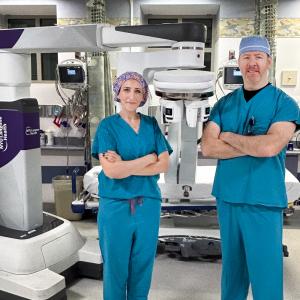Insights from Herbert Lepor, MD, One of the Country’s Foremost Experts on the Disease

Dr. Herbert Lepor, chair of NYU Langone Health's Department of Urology, believes the best option for a low-risk form of prostate cancer may be to not treat it at all.
Photo: Adam Amengual
Men diagnosed with prostate cancer face a bewildering amount of information and agonizing choices about which treatment plan to pursue. Although many of these tumors grow so slowly that they never cause symptoms or become life threatening, others can be more aggressive. Prostate cancer is the second leading cause of cancer deaths for American men. A biopsy can provide clues to a tumor’s lethal potential, but it’s impossible to know for sure.
“Standard biopsies that detect low-risk cancers fail to detect coexisting aggressive cancers about half the time,” notes NYU Langone urologist Herbert Lepor, MD, a leading expert on the disease. “This uncertainty means that some men don’t get treatment when it could be most effective, while others undergo procedures that may be unnecessary.”
The 10-year survival rate for men with early-stage disease who choose active surveillance is extremely high, assuming that they comply with the recommended regimen.
Dr. Lepor, the Martin Spatz Chair of the Department of Urology, explains that because surgery or radiation can cause erectile dysfunction, incontinence, and other problems, the best option for a low-risk form of prostate cancer may be to not treat it at all. But that increasingly popular approach, he adds, can have drawbacks as well.
Five years ago, 85 to 90 percent of patients with early-stage prostate tumors (the type found in most of the 181,000 cases diagnosed annually in the US) chose surgical removal or radiation therapy. Today, according to national surveys, 40 to 50 percent opt for active surveillance, in which the tumor is left untreated but carefully monitored through prostate-specific antigen (PSA) blood tests and biopsies. “There’s been a paradigm shift,” notes Dr. Lepor.
In part, this trend reflects his own research, showing that cancers rated 6 or less on the Gleason scale—a standard measure of aggressiveness—rarely metastasize. Other studies suggest that the 10-year survival rate for men with early-stage disease who choose active surveillance is extremely high, assuming that they comply with the recommended regimen. The problem is that most men don’t comply, largely due to the discomfort and inconvenience of frequent biopsies. Moreover, conventional biopsies, in which samples are taken from random spots throughout the gland, can miss small but aggressive tumors.
Dr. Lepor and his colleagues at NYU Langone are determined to improve detection of aggressive tumors, while avoiding unnecessary treatment for those that are unlikely to ever cause trouble. They have been at the forefront of developing a prostate health index (PHI) blood test, which provides more specific information than the conventional PSA test, as well as multiparametric MRI, a type of magnetic resonance scanning that yields more detailed images than those generated by commonly used techniques. These tests, they believe, afford a clearer picture of a patient’s risk level and can eliminate the need for biopsies in many cases.
When microscopic examination of the tumor is indicated, it’s performed with the aid of another new imaging technique, MRI fusion target biopsy—also developed at NYU Langone—that zeroes in on the suspicious site with unparalleled precision. “The best way to manage low-risk prostate cancer is simply to avoid its detection by not performing random prostate biopsies in men who do not harbor significant disease,” says Dr. Lepor. “We’re trying to screen smarter and biopsy smarter so that we can treat smarter.”

